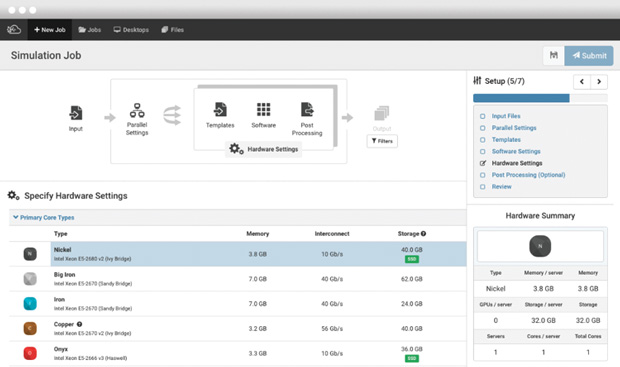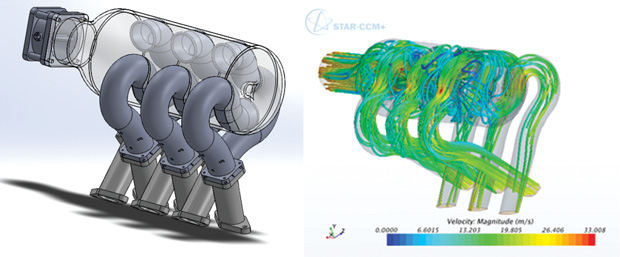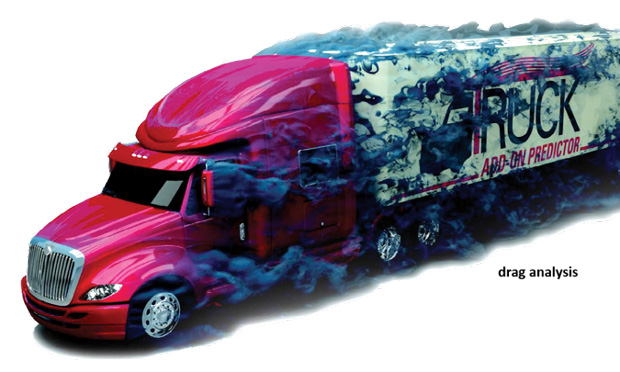
Tractor-trailer aerodynamic drag analysis executed on AweSim platform. Image courtesy of AweSim.
Latest News
November 1, 2016
A new wave of young, visionary organizations and initiatives is making the power of cloud HPC (high-performance computing) resources readily available and accessible to engineering simulation and optimization software users—including many who could never before afford anything close to the full computing horsepower they needed and wanted to run those applications.
One example, San Francisco-based Rescale Inc., offers software platforms and hardware infrastructure that let companies execute engineering and scientific simulations. Its goal, it says, is to “help transform stagnant, on-premise resources into an agile, optimized cloud HPC platform.”
 Rescale’s SaaS web-based workflow is designed to be easy-to-use and includes pre/post-processing and remote desktop features. Image courtesy of Rescale.
Rescale’s SaaS web-based workflow is designed to be easy-to-use and includes pre/post-processing and remote desktop features. Image courtesy of Rescale.Rescale’s cloud simulation and HPC platforms provide a wide range of software and hardware tools in one central location, giving engineers and scientists immediate and unlimited access to the exact resources they need. Rescale’s extensive list of software partners gives users turnkey access to more than 160 simulation software packages. Pricing is either pay-as-you-go or users can employ their own license server.
Rescale explains its core value proposition: “The ability to fully explore the design space requires access to the latest technology in order to improve product conceptions. A team can generate more comprehensive results faster and yield better designs the first time around, giving an organization a significant competitive edge. Rescale’s hardware and software elasticity speeds up product development and optimizes time-to-market.”
In one of the strongest signals yet for the increasingly central role that cloud HPC will play—indeed, is already playing—to expand the availability, affordability and value of CAE, the company recently received $14 million in Series A funding from an investor group led by TransLink Capital. In a press release, Rescale said the investment will support its expansion plans to “help meet the escalating worldwide customer demand for enterprise-class HPC platforms to help large enterprises transition from expensive legacy on-premise systems to a scalable, agile and high-performing cloud computing infrastructure.”
 Automotive engineering firm Carlsson Autotechnik GmbH used SimScale’s pay-as-you-go model to apply fluid flow simulation in aerodynamic development, a capability previously affordable only to Formula One racing teams and major auto OEMs. Image courtesy of Carlsson and SimScale.
Automotive engineering firm Carlsson Autotechnik GmbH used SimScale’s pay-as-you-go model to apply fluid flow simulation in aerodynamic development, a capability previously affordable only to Formula One racing teams and major auto OEMs. Image courtesy of Carlsson and SimScale.The SimScale platform supports an end-to-end simulation workflow starting with CAD model upload, CAD model preparation and automated mesh creation. Analysis types include structural mechanics of parts and assemblies (linear static, nonlinear and dynamic simulations, modal/frequency analysis), fluid dynamics, thermodynamics, particle dynamics and acoustics. After analysis, results can be visualized online in the SimScale post-processing environment, or downloaded.
Yet another example generating high interest is UberCloud, an online community and marketplace where engineers and scientists discover, try and buy on-demand computing power as a service. Engineers and scientists can explore and discuss how to use this computing power to solve their demanding problems, and to identify the roadblocks and solutions, with a crowd-sourcing approach, jointly with the UberCloud engineering and scientific community.
 UberCloud Experiment 187: CFD analysis of automotive V6 intake manifold using an UberCloud software container with STAR-CCM+ in the Azure Cloud. Left: manifold geometry. Right: velocity streamlines from CFD simulation. Image courtesy of CAE Technology Inc. and UberCloud.
UberCloud Experiment 187: CFD analysis of automotive V6 intake manifold using an UberCloud software container with STAR-CCM+ in the Azure Cloud. Left: manifold geometry. Right: velocity streamlines from CFD simulation. Image courtesy of CAE Technology Inc. and UberCloud.The UberCloud community offers free case studies, webinars and discussion forums to help users discover how to use computing power as a service to make their businesses more competitive. The UberCloud Experiment, aimed at users who need to run compute-intensive engineering and scientific simulations, offers free trials for up to 1000 CPU core hours on its computing clusters. The UberCloud Marketplace, a “one-stop-shop to get access to computing resources and fully bundled solutions, on-demand,” offers “computing power and software-as-a-Service” for professional simulation projects. Finally, for software developers and providers—in-house, open-source and commercial—UberCloud develops ready-to-run Application Software Containers intended to ease the usability, accessibility and portability challenges in the development, execution and maintenance of engineering and scientific applications in public and private cloud environments.
A fourth such initiative is AweSim. A partnership among the Ohio Supercomputer Center (OSC), simulation and engineering experts and industry, its aim is to put simulation-driven design capabilities within reach of small to mid-sized manufacturers (SMMs). AweSim builds on OSC’s former Blue Collar Computing initiative to offer a new level of integration and commercialization of products and services for SMMs.
AweSim Director Dr. Alan Chalker explains its mission: “Simulation-driven design replaces physical product prototyping with less expensive computer simulations, reducing the time to take products to market, while improving quality and cutting costs. Smaller manufacturers largely are missing out on this advantage, because they cannot afford to leverage such solutions. We aim to level the playing field, giving the smaller companies equal access.”
More Info
Subscribe to our FREE magazine, FREE email newsletters or both!
Latest News
About the Author
Bruce Jenkins is president of Ora Research (oraresearch.com), a research and advisory services firm focused on technology business strategy for 21st-century engineering practice.
Follow DE






